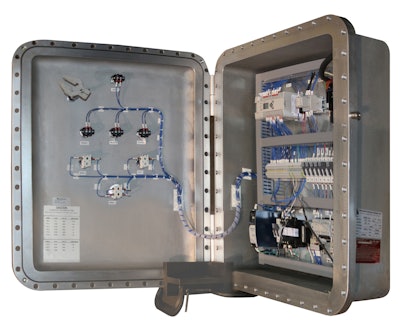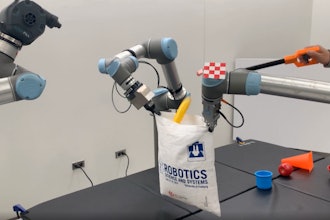
Control panels are the heart of any efficient production environment. Whether it’s a food production factory, nuclear power plant, mainframe computer, or even in an aircraft, control panels act as the central point of control for users to monitor and manage machinery or production lines.
But a control panel is nothing without its counterpart – the enclosure. In a typical process environment, an enclosure keeps the everyday dust and dirt out. In hazardous conditions, it ensures that no rain, wind or debris will harm the central system that keeps production alive.
Below, we go "back to basics" by looking at the control panel's role, its applications, and what the future may hold.
The Anatomy of a Control Panel
In their simplest form, a control panel system can consist of a single on-and-off operation, operated by a foot pedal where hand controls cannot be used to actuate a cycle. For example, in a vitrectomy unit, a foot switch allows an eye surgeon to toggle through multiple presets and stop and start the duty cycle of a cut without needing the use of his hands, which could be preoccupied with stabilizing the patient.
In their most complex form, however, control panels can fill an entire climate-controlled room, working to maintain multiple pieces of automation equipment simultaneously. Digital display controls, for example, can:
- Provide real-time feedback to the user
- Work to reduce the motion nonlinearity to values below 0.001%
- Reduce the deviation of repeated periodic trajectories during motion
- Accurately position motors
The result of more complexity, then, is higher precision and better dynamic performance.
It’s often the case that no one control panel is alike, and consequently, their external shape can vary dramatically in shape and size. Depending on the type of process environment you’re operating in, the enclosure will also vary in shape and size, too.
While obvious, this is an important consideration when deciding on what capabilities you need your control system to perform. For instance, if you’re in a hospital and you’re limited on space and cost, you might find yourself compromising on utility for the sake of an efficiently sized control panel.
Inside a Control Panel
- The inner workings of a control panel can include functionalities like:
- Incoming protection and switching
- Power distribution systems
- Main disconnect switch
- Emergency stop
- Panel meters
- Relays
- Circuit and load protection
Typically, an entire control system will consist of multiple control panels housed in enclosures, all powered by a common power bus. On a fundamental level, each individual section will contain:
- Fuses
- A circuit breaker
- A motor starter
- A power disconnect
A control panel can also include push buttons, indicator lights, metering equipment, variable frequency drives (VFDs) and programmable logic controllers (PLCs).
In today’s ‘smart’ environment, control panels can be accessed and communicated with from anywhere using an ethernet connection. A distributed control system, for example, uses computer software to communicate with motion control hardware from a centralized human-machine interface, which, in some cases, can become portable for the user.
 The advantages of a wireless panel like this one include remote installation of the panel, or workers' freedom of movement.Duff-Norton
The advantages of a wireless panel like this one include remote installation of the panel, or workers' freedom of movement.Duff-Norton
Small implementations of this may consist of a single programmable logic controller connected to a computer in a remote office. But larger distributed control systems will enable remote nodes to operate independently of the central control. These nodes can therefore store process data necessary to maintain operations should there be a communication failure with the central facility.
As a result, modern control panels have become multipurpose automation systems that can run multiple applications at once while maintaining flexible parameters, precision movement and, above all else, decentralized controls that are no longer limited to one place.
What Types of Motion do Control Panels Control?
Control panels work to maintain a consistent and precise level of movement, specifically with the following four types of motion:
1. Jogging
Jogging is the most common type of motion. This type of movement can be achieved either by momentary or maintained motion. When it comes to momentary motion, jogging requires a user to press and hold a push button to ‘jog’ a motor in one direction or another. Maintained jogging requires a user to push a stop/start button once, which will initiate motion.
These buttons will be housed in a small enclosure and will most likely be attached to the machinery itself.
2. Positioning
Positioning movements can be achieved using an AC, DC or servo motor, along with a feedback device. AC, DC and servo drives housed in an enclosure on a control panel will use the feedback device to ensure the position requested matches the final position.
On an automotive assembly line, for example, a robotic arm will repeatedly position a panel to attach to the car. If the parameters of that position are incorrect, or if there is an inconsistency in positioning, the production environment will fail.
3. Synchronization
Synchronization is the movement of two or more electric motors in the same direction together. It provides a means to electrically couple the electric motors. To do this, it requires multiple motor drives, which are housed on a control panel, working together.
4. Variable speed
Variable speed motion is the ability to alter the speed of the motor during its operation. This function is useful in applications where the motor needs to start slowly and ramp up to speed. HMIs, speed potentiometers and selector switches can be used as operator input devices to vary the speed of an electric motor being operated by a variable speed drive.
Can Control Panels be Adapted for Hazardous Conditions?
Control panels can be equipped for different levels of protection depending on the type of motion that is required, and there are two types of standards that dictate the types of protection required.
They are the Ingress Protection (IP) rating system and the National Electrical Manufacturers Association (NEMA). The NEMA rating system is primarily used across the US and Canada, whereas the IP rating system is used throughout the rest of the world.
Both rating systems describe the degree to which a product is protected from water or dust, among other things.
A grain handler on a farm, for example, will require automated equipment that is protected against large amounts of dust. Handling grain is dusty work, and because dust can cause high levels of friction, this can lead to dangerous explosions. Consequently, this environment dictates a need for a well-protected control panel using a safe, secure enclosure.
 Some environments require an explosion-proof enclosure like the one shown in this example.Duff-Norton
Some environments require an explosion-proof enclosure like the one shown in this example.Duff-Norton
Given the risk involved in grain handling, the main controls will need to be protected from things like flammable liquids, gases, sand, dust and vapors. This particular application may also need to have explosion-proof rated enclosures, too, should the worst occur.
Deploying a control panel to a process environment like grain handling, then, will require a certificate for passing the IP or NEMA rating system, and it’ll be custom-built for the hazardous conditions of grain handling to ensure it can operate to its maximum potential without the risk of breaking.
The Control Panel can Make or Break Process Environments
Today’s control panels can operate as stand-alone systems or as part of a larger piece of automated equipment. What’s more, they can work in conjunction with other panels via a network, or they can be hardwired together. While they are undoubtedly more complicated, they make the rest of production simpler, more efficient, and more productive.
In this era of Industry 4.0, we can now use technology to engineer precise movements to ensure high quality and reliable outcomes. In fact, by 2020, Industry 4.0 is expected to bring an average cost reduction of 3.6 percent per annum across process industries globally, totaling $421 billion.
Smart sensors, the Internet of Things, machine learning and big data will all improve the efficiency, productivity and, ultimately, the profit margins of places like factories and nuclear power plants alike, all without needing more staff on the floor.
As these operational efficiencies become apparent with improved bottom lines, we are introducing automation technologies across all areas of the factory floor, including in process environments. Hence, the demand for control systems is on the rise.
Process environments are extremely meticulous – they require many things to work simultaneously, while operating in a precise manner. Only then can you achieve high quality, consistent, and efficient results.
Many engineers now require specific control panels that are custom-built for new and innovative technologies. Your in-house electrical engineer or a third party with control panel expertise would be a good resource to consult when looking to buy a control panel for your next process or machine.
Make Sure to Cover All Bases
Many considerations go into a control panel design. Taking the time to ensure you have covered the bases of environment, control type and communication requirements is a good first step towards developing a control panel.
Because control panels are so varied, it’s worth researching and speaking with an application engineer who can understand your exact requirements and help you customize a control system for your application. With their guidance, you can accurately build a control system that covers all bases and makes your process environment as efficient as possible.
For more information, visit MotionIndustries.com/ien or The Motor Specialist.























